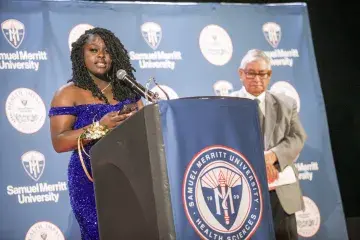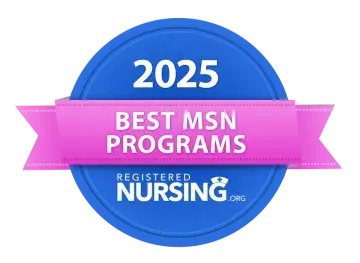Student Nurses Gain Insights into Living with Asthma
SMU nursing student Nicole Masuoka has keen memories of her 21st birthday. Tired after taking college exams, she returned home to a party and her family’s two cats and two dogs. That night, she landed in the hospital with a severe asthma attack.
Her story resonated with the children at Camp Breathe Easy, many of whom said they had been hospitalized as well. The campers complained that having asthma limits what they can do like running fast or participating in the same activities as their friends.
“I felt that as a kid too, but I played sports,” Masuoka, diagnosed with severe asthma at 2 years old, told the campers. “It’s not impossible. You can do it, but it may take a bit more patience than your classmates.”
Inner-city children ages 8 to 12 living with asthma spend several days each August at the Livermore camp, enjoying recreational activities while learning how to better manage their chronic lung disease. Supported by donations, the camp is free except for a small registration fee to pay for transportation.
“It’s humbling to find out that most of the kids here live below the poverty limit,” said Masuoka. “A lot of these kids have never spent much time outdoors or in nature because they spend most of their time inside.”
Masuoka was one of five SMU students in the Entry Level Master of Science in Nursing (ELMNS) program who gained clinical experience at the camp this summer as part of their pediatrics course. Each SMU student was paired up with a nurse, three volunteer counselors and a group of eight to 10 children — marking the first time that nursing students have worked at the camp in its 37-year history.
SMU Assistant Professor Marjorie Hammer, who teaches pediatric nursing, assigns her pre-licensure students to several summer camps for children with a variety of chronic conditions. She said while most clinical experiences for nursing students are centered in hospitals and clinics, working at the camps gives them insights into what it means for children to live with disease in their daily lives.
“The students came to understand the capabilities of young children to handle chronic and even life-threatening disease that affects daily function and the challenges these children face related to health inequities,” she said.
Studies show that children who live in poverty in urban areas are at higher risk of developing asthma, according to Hammer, and African Americans in particular face more frequent hospitalizations and a far greater risk of dying from the disease.
“They have lives and it’s not always easy for them to even get to camp,” said camp director Mindy Benson, a nurse practitioner at UCSF Benioff Children’s Hospital in Oakland, where most of the campers are patients.
“Sometimes asthma is the least of their problems,” said Benson, who noted that the children’s families often face food and housing insecurity as well as domestic violence.
Asthma affects people of all ages, but it most often starts during childhood. In the United States, more than 25 million people are known to have asthma, with 7 million of them being children, according to the National Institutes of Health. While the exact cause of asthma isn't known, researchers think some genetic and environmental factors interact to cause asthma, most often early in life.
Trends in prevalence in some populations suggest that exposure to indoor allergens such as dampness, mold and dust mites as well as outdoor air pollutants elevate the risk of developing respiratory diseases like asthma. Low-income communities are disproportionately impacted due to their exposure to traffic-related pollution and poor-quality housing.
ELMNS student Lan Ngo said she learned more about asthma by working at Camp Breathe Easy than she had expected. What surprised her the most, she said, was that the majority of the kids did not know how to use their inhalers properly. She learned along with the campers by watching the nurses demonstrate the proper technique.
“It took time and patience, but my group of girls demonstrated correct technique by the end of camp,” said Ngo.
Despite growing up with asthma, Masuoka said she welcomed the opportunity to learn about how this new generation of kids deal with their condition and wishes she had a similar camp experience.
“These campers knew more about asthma than I did at their age, which may be because I had the privilege of having a supportive family at home who were proactive,” she said. “This experience definitely was eye-opening and humbling.”


